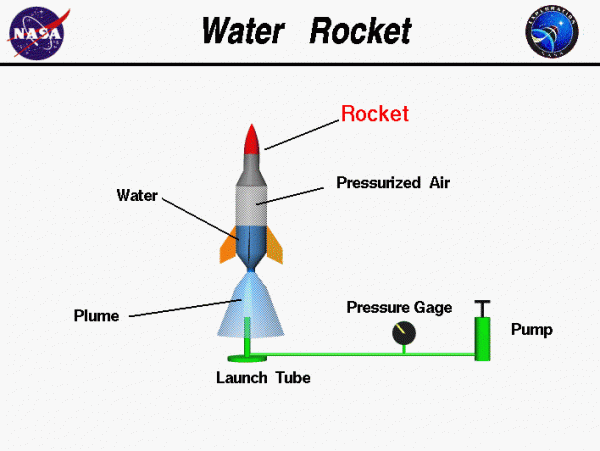Water Rocket

Flying Model Rockets
Flying model rockets is a relatively safe and inexpensive way for students to learn the basics of forces and the response of a vehicle to external forces. A model rocket is subjected to four forces in flight: weight, thrust, and the aerodynamic forces, lift and drag. There are many different types of model rockets. One of the first and simplest type of rocket that a student encounters is the bottle, or water rocket. The water rocket system consists of two main parts, the launcher and the rocket.
Generic Launcher
On the figure we show a generic launcher, although launchers come in a wide variety of shapes and sizes. The launcher has a base to support the rocket during launch. A hollow launch tube is mounted perpendicular to the base and is inserted into the base of the rocket before launch. The launch tube is connected to an air pump by a hollow feeder line. The pump is used to pressurize the inside of the body tube to provide thrust for the rocket. We have attached a pressure gage to the feeder line to display the change in pressure in the system. This part of the system is very similar to the simple compressed air rocket.
Components of the Rocket
The other part of the water rocket system is the rocket itself. Usually, the rocket is made from a 2-liter soda pop bottle. Before launch, the bottle is filled with some amount of water, which acts as the “propellant” for the launch. Since water is about 100 times heavier than air, the expelled water produces more thrust than compressed air alone. The base of the bottle is only slightly larger than the launch tube. When the rocket is placed on the launch tube, the body tube becomes a closed pressure vessel. The pressure inside the body tube equals the pressure produced by the air pump. Fins are attached to the bottom of the body tube to provide stability during the flight.
An Important Exception
The flight of a water rocket is similar to the flight of a compressed air rocket with one important exception. The mass of the bottle rocket varies during the flight because of the exhausting water plume. There are equations which have been developed for full scale rockets that account for this loss of mass. You can study the flight of a bottle rocket by using the RocketModeler III flight simulator. Because of the popularity of bottle rockets, we have an entire section of this web site devoted to water rockets.
